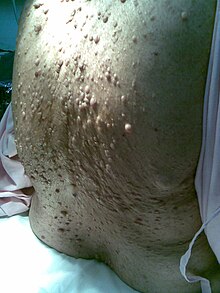
Back ورام ليفي عصبي Arabic Neurofibromatosi Catalan Neurofibromatóza Czech Neurofibromatose Danish Neurofibromatose German Neurofibromatosis Spanish Neurofibromatosi Basque نوروفیبروماتوز Persian Neurofibromatose French נוירופיברומטוזיס HE
| Neurofibromatosis | |
|---|---|
 | |
| Back of an elderly woman with neurofibromatosis type 1 | |
| Specialty | Neurosurgery, neurology, Neuro-oncology |
| Symptoms | Small lumps within the skin, scoliosis, hearing loss, vision loss[1] |
| Usual onset | Birth to early adulthood[1] |
| Duration | Life long[1] |
| Types | Neurofibromatosis type 1 (NF1), neurofibromatosis type 2 (NF2), schwannomatosis[1] |
| Causes | Genetic[1] |
| Diagnostic method | Symptoms, genetic testing[2] |
| Treatment | Surgery, radiation therapy[2] |
| Prognosis | NF1: variable, but most of the time normal life expectancy[1] NF2: shortened life expectancy[1] |
| Frequency | 1 in 3,000 people (United States)[1] |
Neurofibromatosis (NF) refers to a group of three distinct genetic conditions in which tumors grow in the nervous system.[1] The tumors are non-cancerous (benign) and often involve the skin or surrounding bone.[1] Although symptoms are often mild, each condition presents differently. Neurofibromatosis type I (NF1) is typically characterized by café au lait spots (light-brown flat patches of skin), neurofibromas (small bumps in or under the skin), scoliosis (side-way curvature of the back), and headaches.[2] Neurofibromatosis type II (NF2), on the other hand, may present with early-onset hearing loss, cataracts, tinnitus, difficulty walking or maintain balance, and muscle atrophy.[2] The third type is called schwannomatosis and often presents in early adulthood with widespread pain, numbness, or tingling due to nerve compression.[3]
The cause is a genetic mutation in certain oncogenes.[1] These can be inherited, or in about half of cases spontaneously occur during early development.[1] Different mutations result in the three types of NF.[4] Neurofibromatosis arise from the supporting cells of the nervous system rather than the neurons themselves.[1] In NF1, the tumors are neurofibromas (tumors of the peripheral nerves), while in NF2 and schwannomatosis tumors of Schwann cells are more common.[1] Diagnosis is typically based on symptoms, examination, medical imaging, and biopsy.[5][3] Genetic testing may rarely be done to support the diagnosis.[2]
There is no known prevention or cure.[1][2] Surgery may be done to remove tumors that are causing problems or have become cancerous.[1] Radiation and chemotherapy may also be used if cancer occurs.[1] A cochlear implant or auditory brainstem implant may help some who have hearing loss due to the condition.[1]
In the United States, about 1 in 3,500 people have NF1 and 1 in 25,000 have NF2.[1] Males and females are affected equally often.[2] In NF1, symptoms are often present at birth or develop before 10 years of age.[1] While the condition typically worsens with time, most people with NF1 have a normal life expectancy.[1] In NF2, symptoms may not become apparent until early adulthood.[1] NF2 increases the risk of early death.[1] Descriptions of the condition occur as far back as the 1st century.[6] It was formally described by Friedrich Daniel von Recklinghausen in 1882, after whom it was previously named.[4]
- ^ a b c d e f g h i j k l m n o p q r s t u v w "Neurofibromatosis Fact Sheet". NINDS. 3 February 2016. Archived from the original on 23 January 2018. Retrieved 16 April 2018.
 This article incorporates text from this source, which is in the public domain.
This article incorporates text from this source, which is in the public domain.
- ^ a b c d e f g "Learning about Neurofibromatosis". National Human Genome Research Institute (NHGRI). 16 August 2016. Archived from the original on 10 October 2016. Retrieved 7 November 2016.
 This article incorporates text from this source, which is in the public domain.
This article incorporates text from this source, which is in the public domain.
- ^ a b Dhamija R, Plotkin S, Asthagiri A, Messiaen L, Babovic-Vuksanovic D, Adam MP, Mirzaa GM, Pagon RA, Wallace SE, Bean LJH, Gripp KW, Amemiya A (1993). "LZTR1- and SMARCB1-Related Schwannomatosis". Schwannomatosis. University of Washington, Seattle. PMID 29517885. Retrieved 21 November 2019.
{{cite book}}:|website=ignored (help) - ^ a b Woodrow C, Clarke A, Amirfeyz R (1 June 2015). "Neurofibromatosis". Orthopaedics and Trauma. 29 (3): 206–210. doi:10.1016/j.mporth.2015.02.004. ISSN 1877-1327. S2CID 239484110. Retrieved 22 November 2019.
- ^ Le C, Bedocs PM (January 2019). Neurofibromatosis. StatPearls. PMID 29083784.
- ^ Ferner RE, Huson S, Evans DG (2011). Neurofibromatoses in clinical practice. London: Springer. p. 1. ISBN 978-0-85729-628-3. Archived from the original on 10 September 2017. Retrieved 9 October 2015.
© MMXXIII Rich X Search. We shall prevail. All rights reserved. Rich X Search